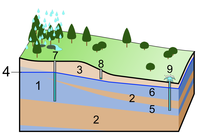
Photo from wikipedia
The surface and groundwater resources are depleting over time, therefore, it becomes essential to monitor and preserve these resources and also to protect their quality. Remote sensing and GIS has… Click to show full abstract
The surface and groundwater resources are depleting over time, therefore, it becomes essential to monitor and preserve these resources and also to protect their quality. Remote sensing and GIS has become an important tool of hydrological studies in recent times which helps in assessing and mapping of ground-water resources. The remote sensing and GIS approach are well known and widely used techniques to integrate contributing hydrogeological factors namely, geology, geomorphology, lineaments density, drainage density, soil type, slope and land use/land cover. A study was conducted to delineate the groundwater potential zones in a part of Sidhi area, Madhya Pradesh using remote sensing and GIS techniques. Landsat 8 satellite data and Aster DEM is integrated with toposheets for systematic mapping. All thematic layers were integrated, overlaid and analysed using GIS software. Groundwater potential zone is delineated and to interpret thematic layer, appropriate weights assigned to topographical features for assessing the potential zone. The zones are divided into high, moderate and low groundwater potential zones. The study reveals that 21.36% of the area has high potential, 48.12% moderate and 30.51% low potential zone for groundwater occurrence. The result of this study suggests that the favourable potential zones would prove to be very helpful for better planning and management of groundwater resources in the study area.
Journal Title: Journal of the Geological Society of India
Year Published: 2020
Link to full text (if available)
Share on Social Media: Sign Up to like & get
recommendations!